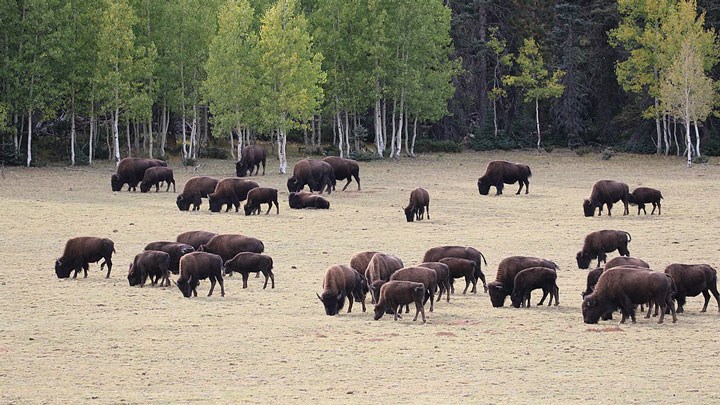
by Karen Mehall Phillips - Wednesday, November 17, 2021

Reports from Arizona’s Grand Canyon National Park (GCNP) cite that more than 45,000 people applied to be one of 12 hunter-volunteers in its fall pilot program aimed at helping to cull its expanding bison population along the North Rim, which at an estimated 400 to 600 animals far exceeds the carrying capacity of 200. According to the National Park Service (NPS), a total of four animals were removed, with two hunter-volunteers having to back out, bringing the number of participants to 10. While park managers fell short of their harvest goal of 12 animals, any opportunity to pursue the species in a sustainable manner marks a wildlife conservation success story considering it was once on the brink of extinction.
As explained by AZcentral.com, successful applicants had to meet multiple NPS and Arizona Game and Fish Department requirements, starting with demonstrating marksmanship proficiency and having the ability to navigate challenging backcountry terrain at 8,000 feet above sea level. Three hunter-volunteers went afield each week between late September and October. Once a bison was down, hunters sent their GPS coordinates to park staff, who assisted with field dressing and transport on foot as no off-road vehicles were permitted. Only female bison were harvested as the removal of cows is what most ensures population reduction. This fact also trounces any misconceptions that anti-hunters put forth in trying to label the culling operation a so-called “trophy” hunt within park boundaries.
But those against hunting were not about to let the truth get in their way. As this NRA website tracked, on Sept. 17, just three days before the first hunt, Wayne Pacelle, the disgraced former CEO of the Humane Society of the United States (HSUS) and founder of Animal Wellness Action (AWA), organized a letter campaign with several legislators in Congress pushing for the National Park Service (NPS) to cancel the culling operation at GCNP. Addressed to Secretary of the Interior Deb Haaland and Deputy Director Shawn Benge, the letter urged the use of non-lethal and costly management alternatives such as relocating some bison to Colorado. It intimated that since hunting had not been permitted in the area that the GCNP now occupies for more than a century it should not be allowed now. It dismissed that the NPS has the authority to kill animals that harm resources whether by using staff, sharpshooters or hunter-volunteers.
Sadly, those who undercut hunting’s critical role as a wildlife management tool do not seem to grasp the NPS’ immediate concerns over the fact the number of bison the GCNP can support without environmental degradation is only 200 animals. As far back as 2019, the NRA Hunters’ Leadership Forum (HLF) reported that the bison population had to be trimmed to rescue native vegetation and biodiversity from the species’ rampant destruction. Today increased environmental impacts extend to “water, vegetation, soils, archaeological sites and values such as visitor experience and wilderness character.” While lethal removal was one of the tools outlined in a 2017 plan approved after an environmental review, guidelines for the culling program were not established until earlier this year.
In giving credit where it is due, it was the NRA and Safari Club International (SCI) that for years pressed the NPS to allow hunters to assist with culling overpopulated ungulates on national park lands. The NPS dug in its heels, favoring the use of contract sharpshooters and federal personnel, partly to avoid battling the antis over allowing “hunting” in park boundaries. The NPS also claimed that using volunteer cullers would be illegal and costly. Thanks to continued pressure from NRA and SCI, the NPS conducted the Rocky Mountain National Park and Theodore Roosevelt National Park study using hunters to reduce elk populations. When the study report was released in 2016, it confirmed that the use of hunter-volunteers in culling operations on NPS units was legal, cost effective and a great idea. In 2019, the NRA-backed Senate Bill 47 was signed in Public Law specifically authorizing the NPS to use qualified volunteers to reduce the size of wildlife populations (Public Law No.116-9).
Prior to permitting the use of hunter-volunteers, GCNP herd reduction hinged on corralling bison near the park’s North Rim entrance and shipping them to Native American tribes through the Intertribal Buffalo Council, comprised of 69 federally recognized tribes in 19 states. According to GCNP wildlife biologist Greg Holm, the park has relocated 124 of the animals over the past three years. Cherokee Nation Principal Chief Chuck Hoskin Jr. says bison are an essential source of food, clothing, shelter and tools and continue to be used in tribal ceremonies.
GCNP officials will meet soon to determine whether to conduct the culling operation in 2022.
The Grand Canyon bison herd descended from bison that were introduced into northern Arizona in the early 1900s in ranchers’ efforts to crossbreed them with cattle. Outside the GCNP boundary, Arizona has an annual draw for tags on the Kaibab National Forest.
E-mail your comments/questions about this site to:
[email protected]
